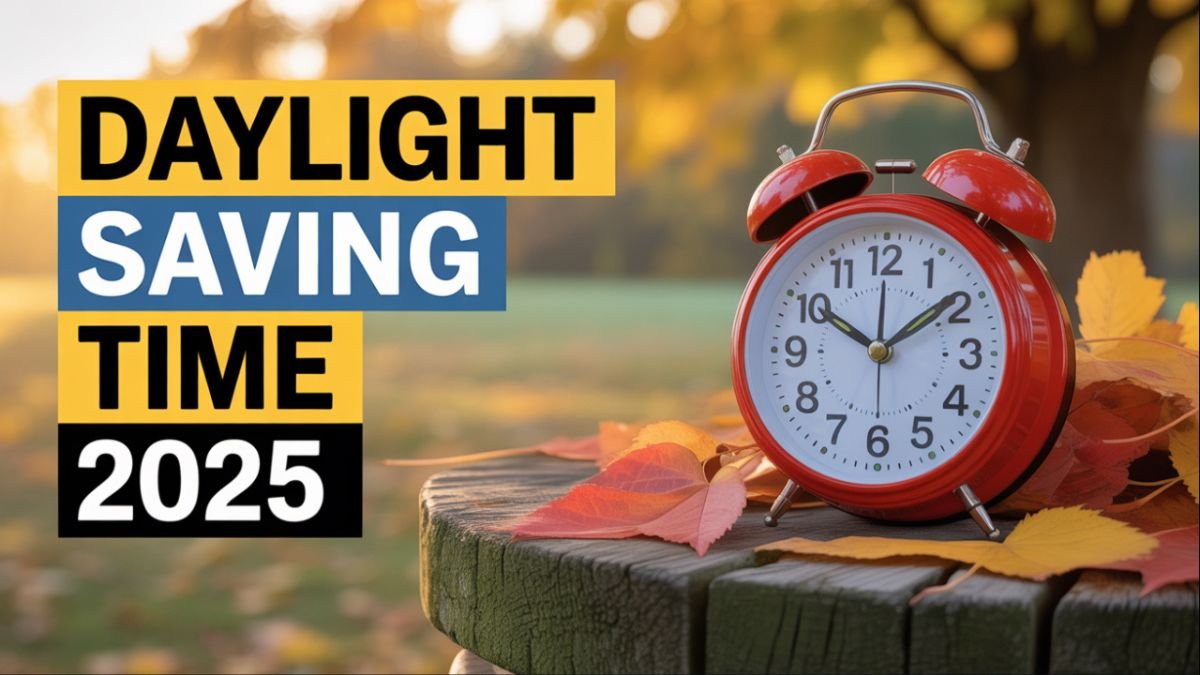Daylight Saving Time 2025: Every year, as October and November roll around, people across the United States prepare for a small yet significant change — turning the clocks back by one hour. Known as the end of Daylight Saving Time (DST), this adjustment signals the arrival of darker evenings, cooler weather, and, for many, a bit of confusion.
This year, Daylight Saving Time will end on Sunday, November 2, 2025, when clocks will be set back one hour at 2 a.m. to 1 a.m. While smartphones and computers adjust automatically, many still find themselves double-checking the wall clock or car time. But beyond this small inconvenience lies a much bigger question: Do we really still need Daylight Saving Time?
What Is Daylight Saving Time?
Daylight Saving Time (DST) is a system designed to make better use of natural daylight during the longer days of summer. The concept is simple: move the clock forward by one hour in spring (“spring forward”) to have more daylight in the evenings, and then move it back in fall (“fall back”) to return to standard time.
The United States officially adopted DST in 1966 under the Uniform Time Act. According to this act:
- Clocks are set forward by one hour on the second Sunday of March
- Clocks are set back by one hour on the first Sunday of November
In 2025, DST began on March 9th and will end on November 2nd.
The History and Purpose of Daylight Saving Time
The main idea behind DST was to save energy and make better use of daylight. During World War I and II, many countries implemented DST to conserve fuel and electricity. People could work longer under natural light and reduce the use of lamps and candles.
When the Uniform Time Act was passed in 1966, the U.S. standardized the practice nationwide. For decades, the system seemed logical — more daylight meant more productivity and less energy consumption.
However, in today’s world of 24/7 electricity, digital devices, and flexible work hours, the benefits of DST have come under heavy scrutiny. Modern research suggests that energy savings are minimal — often less than 1% — while the health and safety risks have increased.
An Hour of Sleep: Blessing or Burden?
When DST ends in November, many people celebrate gaining an extra hour of sleep. For those juggling busy schedules, it feels like a much-needed gift. But experts warn that the body doesn’t adjust instantly.
This time shift can disrupt the circadian rhythm, our body’s internal clock that regulates sleep and wakefulness. The effects can include:
- Fatigue and lethargy
- Mood swings
- Difficulty concentrating
- Increased irritability
According to the American Sleep Research Institute, the first few days after the time change see a rise in car accidents, heart issues, and workplace errors. Shift workers, parents of young children, and the elderly are especially vulnerable to these effects.
In essence, while the “extra hour” may sound good, the biological confusion that follows can take days or even weeks to stabilize.
Growing Controversy and Political Debate Over DST
Every few years, the debate over the usefulness of DST resurfaces in the U.S. Some argue it’s an outdated system that no longer fits modern lifestyles, while others defend it as a beloved tradition that extends daylight in summer evenings.
In April 2025, former President Donald Trump reignited the debate when he stated that DST should be made permanent to avoid the hassle and cost of changing clocks twice a year. Interestingly, in December 2024, he had expressed the opposite opinion, calling for DST to be abolished entirely and for the U.S. to adopt permanent Standard Time.
This contradiction highlights how DST is not just about time — it’s also about political viewpoints, regional preferences, and lifestyle choices.
- Supporters of DST enjoy longer daylight hours in the evening for outdoor activities and recreation.
- Opponents argue that earlier sunrises in the morning are safer for school children and workers commuting in the dark.
Time Reform and the Stalled Issue in Congress
DST reform has been a hot topic in Congress for years, but so far, no permanent solution has been passed.
The Sunshine Protection Act, first approved by the Senate in 2022, proposed making DST permanent nationwide. However, the bill stalled in the House of Representatives, where debates continue over whether Standard Time or Daylight Time should be the permanent choice.
In 2025, the bill was reintroduced, but once again, progress has been slow. Lawmakers are divided, and until an agreement is reached, Americans must continue to change their clocks twice a year.
Pennsylvania and Other States’ Initiatives
Several states are taking their own steps to address the DST dilemma.
In March 2025, Pennsylvania passed a resolution urging Congress to end what it called an “outdated tradition.” Over the past few years, more than 29 states have introduced similar resolutions requesting permission to make DST permanent or abolish it altogether.
However, under federal law, no state can unilaterally decide to change the time system — they need Congressional approval.
Currently, the following U.S. states and territories do not observe DST:
- Hawaii
- Most of Arizona
- Puerto Rico
- Guam
- American Samoa
- U.S. Virgin Islands
- Northern Mariana Islands
These regions stay on Standard Time year-round, avoiding the biannual confusion altogether.
What Will Happen on November 2, 2025?
As per tradition, Daylight Saving Time will officially end at 2 a.m. on Sunday, November 2, 2025. At that moment, clocks will move back one hour to 1 a.m.
Here’s what that means:
- Mornings will be brighter earlier in the day.
- Evenings will darken sooner, often before 6 p.m. in many regions.
- The shift marks the transition toward winter, with shorter days, longer nights, and colder weather ahead.
For some, this change signals cozy evenings and more rest. For others, it can trigger seasonal affective disorder (SAD) — a type of depression linked to reduced daylight exposure.
Is Daylight Saving Time Still Necessary?
The original purpose of DST — saving energy — has largely faded in relevance.
Modern studies show that the energy saved is negligible, as most households now use electricity consistently regardless of daylight. Moreover, the use of air conditioning, electronics, and artificial lighting has offset any potential savings.
Experts now argue that the harm outweighs the benefit. DST has been linked to:
- Higher rates of workplace and traffic accidents immediately after clock changes.
- Disrupted sleep cycles, especially in children and older adults.
- Increased stress levels and temporary drops in productivity.
- Negative effects on physical and mental health.
Given these findings, more policymakers and scientists are calling for one permanent, uniform time throughout the year.
Will This Tradition Ever End?
The fate of DST remains uncertain. While public opinion is shifting toward ending the clock changes, Congress has yet to take definitive action.
Political disagreements, differing regional preferences, and logistical concerns (such as coordinating with neighboring countries) have all delayed progress.
Until a law is passed, Americans must continue the biannual ritual — “spring forward” in March and “fall back” in November — just as they have for decades.
Calculating the DST Change in 2025
| Event | Date | Time | Adjustment |
|---|---|---|---|
| DST Begins | March 9, 2025 | 2:00 a.m. → 3:00 a.m. | Clocks move forward 1 hour |
| DST Ends | November 2, 2025 | 2:00 a.m. → 1:00 a.m. | Clocks move back 1 hour |
So, when you wake up on Sunday, November 2, 2025, your phone will already show the correct time, but don’t forget to manually change your wall clocks, microwaves, and car displays.
Conclusion: An Extra Hour of Sleep and a New Debate
As Daylight Saving Time ends in 2025, you’ll enjoy an extra hour of rest, but also face an age-old question — is this tradition still worth it?
While DST once helped conserve energy and align human activity with daylight, modern lifestyles and technology have made it largely obsolete. The ongoing debate in Congress and across the states shows that change may be coming, but not quite yet.
So, as you turn your clock back this November, take a moment to reflect:
Do we still need to change time twice a year, or is it time to let time itself stand still?
FAQs About Daylight Saving Time 2025
Q1. When Does Daylight Saving Time End in 2025?
A. DST ends on Sunday, November 2, 2025, when clocks are set back one hour at 2 a.m.
Q2. Why Do We Observe Daylight Saving Time?
A. DST was created to make better use of daylight, save energy, and give people longer evenings during the summer months.
Q3. Which U.S. States Do Not Observe DST?
A. Hawaii, most of Arizona, Puerto Rico, Guam, American Samoa, U.S. Virgin Islands, and Northern Mariana Islands do not observe DST.
Q4. Does Changing the Clocks Affect Health?
A. Yes. The time shift can disrupt your body’s circadian rhythm, leading to fatigue, sleep issues, and a temporary rise in road and workplace accidents.
Q5. Will DST Ever Be Permanently Abolished in the U.S.?
A. Discussions are ongoing in Congress, but no permanent law has been passed yet. For now, Americans must continue to change their clocks twice each year.









